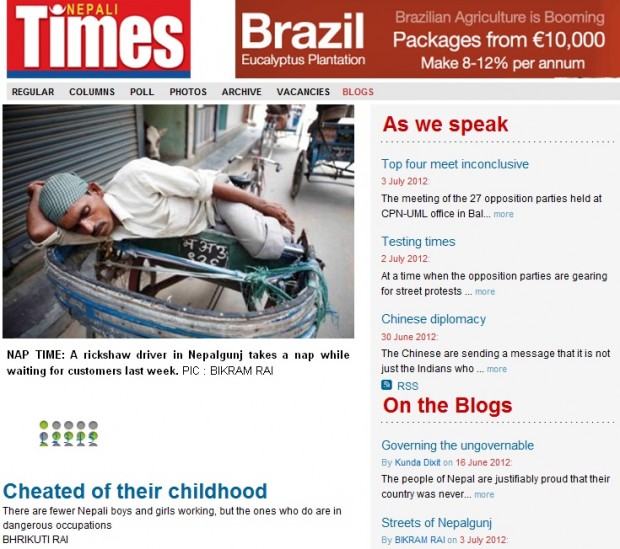Major news in Nepal : Cheated of their childhood
Top news in <Nepali Times>: Cheated of their childhood
There are fewer Nepali boys and girls working, but the ones who do are in dangerous occupations
BHRIKUTI RAI
Every day Bikash gets out of his makeshift bed at 5 am and can’t get back till late at night. The eight-year-old came to Kathmandu from Morang and has been working at this restaurant in Baneswor for the past six months. With half-opened eyes, which makes it seem like he is sleep-walking, Bikash drags himself towards the kitchen where his scrawny little hands dip a tattered towel in a bucket of water.
“It’s difficult especially in winter but I have been working since I was six,” he tells a visitor matter-of-factly, and with a swagger mature for his age. Then he goes back to mopping the restaurant floor.
There are an estimated 1.5 million Nepali child workers like Bikash between 5-17 years. Even though the minimum legal age of employment in Nepal is 14, children as young as six can be seen working in roadside restaurants, factories, offices, and even in homes.
“Poverty and lack of opportunities are driving many families to use children as safety nets and sending them out to earn without caring about the physical and psychological dangers involved,” says Helen Sherpa of World Education, which has been working on educational projects to combat child labour in Nepal.
Although the number of child workers under-14 has dropped from a staggering 2.6 million ten years ago, surveys show there has been an alarming rise in the number of children working in hazardous environments like mines, brick kilns, factories and entertainment industries.
Embroidery factories that make jari fabric, dance bars, massage parlours and cabin restaurants have become new hotspots for the exploitation and abuse of child workers in Nepal.
“Eleven to twelve year old girls are working in dance bars and restaurants,” says Pramesh Pradhan of Change Nepal, which works with women and children in the ‘entertainment business’. “These days Nepali girls are smuggled not just to India but also within the country. There has been a surge of young girls forced into commercial sex work.”
After the clampdown on jari factories in India, many young Indian boys and girls have been found in fabric factories across Nepal. Children as young as five are forced to work up to 14 hours a day because they are docile and have nimble fingers.
Although the government had pledged to end all forms of child labour by 2014 it was revised in 2010 and extended until 2020 due to the political instability. “The issue of child labour had to take a back seat, because of the turmoil in the country. But now we are committed to end the worst forms of child labour in the next four years and all child labour by 2020 ,” says Krishna Prasad Dawadi, Under Secretary at the Ministry of Labour and Employment.
However, child rights activists believe that legislation alone will not be enough, there has to be job opportunities for adults so the children don’t have to work. Says Madhav Pradhan of Child Workers in Nepal (CWIN), a children’s organisation that runs a free helpline and carries rescues children from risky working environments: “Protecting former child labourers is important and so is making sure parents are earning enough so that they don’t make their children work, all this takes time.”
Unfortuantely for hundreds of thousands of children like Bikash, time has passed them by, and they will never enjoy childhood.

























































